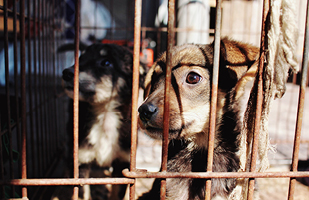Animal Cruelty Used as a Domestic Violence Weapon

The pandemic has created a greater need for access to help and resources for all households experiencing domestic violence, including pets.

The pandemic has created a greater need for access to help and resources for all households experiencing domestic violence, including pets.
Among the hidden tools of domestic violence perpetrators is animal cruelty.
Abuse of a victim’s comfort animal or pet has come into focus as an offshoot of the COVID-19 pandemic, according to a new study in Ohio.
Alana Van Gundy, a Miami University professor and board member of Ohio Animal Advocates (OAA), writes in the study that perpetrators commonly harm pets as a scare tactic to control their partners.
Given the numerous ways abusers control their victims, including transportation, finances, and phone access, many survivors aren’t able to leave their home or even call for help.
Animal abuse can be a part of the cruel equation where many victims of intimate partner violence will choose to stay in the abusive situation if fleeing means leaving their pets with their abuser. The National Coalition Against Domestic Violence estimates that could be up to 40% of survivors.
The OAA study, “COVID-19, Domestic Violence, and Animal Abuse in Ohio,“ was released by the nonprofit that promotes policies and enforcement of animal protection laws.
The report details how safeguards for the pets of survivors of intimate partner violence can benefit their abused owners.
If an animal companion is given a safe haven – in a secure environment with the victim or by itself at a rescue facility – the survivor’s likelihood of escape is increased.
Lutheran Social Services (LSS) in Franklin County has a shelter solely dedicated to victims of domestic violence – CHOICES. In July 2019, it added an on-site kennel to provide relief and comfort to people and pets in need of security.
“We want people to come to safety reassured and not worry about what they've left behind,” said Elizabeth Abdur-Raheem, LSS CHOICES’ executive director. “Pets are stabilizing, and knowing they’re OK, helps these people stand on their feet and move forward.”
The pandemic has made an existing problem much worse.
COVID-19 has “placed increased pressure on survivors and their companion animals” as services from law enforcement, courts, and social service agencies over the past 14 months have been stretched, OAA Executive Director Vicki Deisner said.
The document assesses the availability of online links and information for domestic violence survivors, and how to file restraining orders through the Ohio Supreme Court’s website and all 88 county governments.
“Global evidence suggests that the need for domestic violence resources and protection from abusers has increased during this time, yet access to resources and protection has become highly limited,” said Van Gundy.
As a way to ensure those in need of help can file a police report or submit requests for protection orders, Van Gundy stresses the need for online resources that are simple, consistent, and easily attainable.
Ideally, she says, a person should be able to fill out the forms directly on a county website from their computer or mobile device.
Other recommendations in the report expand survivor safety, such as courts holding protection order hearings by video conference, the ability to apply for a protection order outside of a victim’s residing county, and statewide education for court personnel and law enforcement about the intricacies of domestic violence and animal abuse.
Since 2014, court forms should include specifications for pets after the Ohio legislature passed Senate Bill 177, which permits a court to include protections for a companion animal within the scope of a protection order.
The Supreme Court offers standardized civil protection order forms for courts, including domestic violence and dating violence protection orders.
The Supreme Court Domestic Violence Program is partnering with Ohio Legal Help to put the protection order forms on the legal aid service’s website with easily accessible language, along with referral information for lawyers and advocates in the survivor’s area.
The project is expected to be completed this summer.


